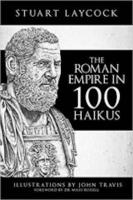
Amberley (2019) p/b 224pp £12.99 (ISBN 9781445693309)
This is an ambitious concept, covering the Roman Empire from the end of the Republic to the legacy of Rome today. How L. made his choice of one hundred subjects over the course of the span of the Empire is one to ponder, given the vast amount of material at his disposal.
In his clear and concise introduction, giving a brief history of the Roman Republic, L. admits that he has had to omit much material but hopes that what is there is fresh and interesting to the reader. It is.
The format is deceptively simple. Each double page contains an original Haiku poem with an explanatory note below and an original illustration on the facing page.
As well as tackling individual historical events from the period, e.g. ‘Actium, 31BC’ or ‘The Fall of Constantinople’, L. intersperses these specific events with more general topics, e.g. ‘Chariot Racing Teams’ or ‘Saturnalia’, or pieces on individuals, e.g. ‘Messalina’ or ‘Riothamus’. This works well, as the whole is not some dusty trawl through each emperor’s reign; and the lay person gets, in many cases, an idea of the more obscure historical figures or aspects of Roman culture that were important both to them and to us today. However, the necessary brevity of the explanatory text does mean that, if the reader dips in and out, those unfamiliar with basic facts (e.g. that Caius was the Emperor Caligula) may have to look back to an earlier text.
Haikus are not a familiar poetical form for many and they take some getting used to, with their brevity and the need to get across the essence of the title on the page. Most of these work really well. L. surely had great fun and many frustrating hours juggling the need to be brief while making the poem relevant. One of the best for me was ‘Sejanus and Tiberius’:
‘An old goat lost in
capricious Capri capers
still his horns are sharp’
The historical background piece accompanying this clever haiku enhances one’s understanding of the poem and adds relevant and intriguing details leaving, in this case, little to the reader’s imagination. Since I admit to lacking detailed knowledge of the later Roman Empire, reading the haikus and trying to work out their meanings before a glance at the texts below to see whether I had been on the right lines was an amusing diversion which also taught me, in little snippets, some very interesting history.
The illustrations are striking, though I was not always sure whether they enforced the point of the topic. Though supposedly original, some were copies of well-known pieces, e.g. from the Arch of Titus. Nevertheless, this is a slight criticism and they were beautifully drawn; sometimes simple, sometimes complex, but always visually appealing. There is a brief chronology of key events of the period as an appendix but, as L. takes us to so many parts of the empire, a map might have been useful too.
This is a book which one can either follow chronologically or pick a random page to read. It is well researched and a pleasure to take on one’s travels. It opens up aspects of Roman life and history that anyone with only a little knowledge of Roman history, or indeed a fuller one, would find enjoyable and enlightening.
In sum:
‘History, culture,
Laycock pairs you up with skill
delightful result’
Mike Smith
